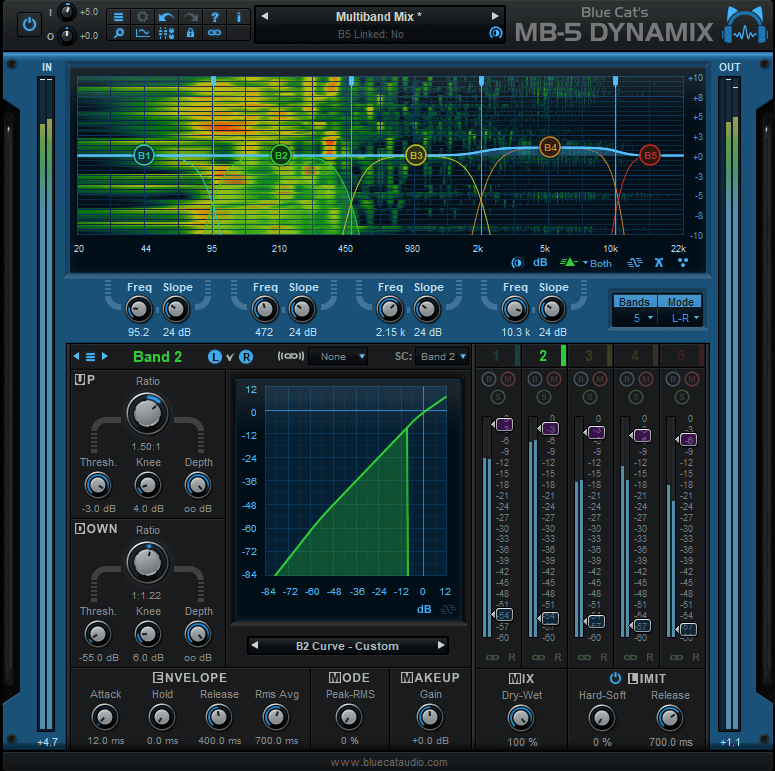Table Of Content
Introduction
Blue Cat's MB-5 Dynamix is an extremely powerful all-in-one multiband dynamics processor: it can be used as a multiband compressor, limiter, gate, expander, waveshaper or all combined at once, on any part of the spectrum.
The unique dynamics processing section of the Blue Cat's Dynamics plug-in has been streamlined and integrated in this plug-in to process each one of the 5 bands separately.
The plug-in provides unique envelope detection capabilities that let one band trigger the dynamics response on others (internal side-chain). Combined with the advanced stereo features including mid/side processing and independent channels activation, it gives you full control over the dynamics of the signal for a wide range of effects.
An additional brick wall limiter/clipper protects the output for complete control over the dynamics response.
The plug-in provides comprehensive visual feedback to let you know what's exactly going on at every step of the dynamics processor: for each channel, monitor the spectrum, the in/out levels, dynamics response, compression ratio and in/out level of each band...
The user interface has been designed to streamline the workflow, and despite the wide range of functionalities offered by the plug-in, it is extremely easy to use. Inter-bands controls (copy/paste, link...) lets you create complex treatments with a few clicks.
Thanks to its advanced MIDI and automation output capabilities, Blue Cat's MB-5 Dynamix is capable of advanced side-chaining features: you can control other plug-ins with the output of the dynamics processing stage for simple side chain dynamics effects or more advanced signal-dependent effects. Check out our MB-5 Dynamix Tutorials for more details.
If you are looking for a broadband dynamics processor, check out the Blue Cat's Dynamics plug-in.
Typical applications: Multiband dynamics correction and modeling, mastering, loudness maximizing, dynamic equalization, de-essing, pop removal, multiband wave shaping, spectrum-based side chain effects.
Credits: this plug-in includes many factory presets created by Sink.
System Requirements
MacOS
- An Intel or Apple Silicon processor.
- Mac OS 10.9 or newer.
- Any VST / Audio Unit / AAX compatible application (64-bit) .
Windows
- An SSE2-enabled processor (Pentium 4 or newer).
- Microsoft Windows Vista, Windows 7, 8 or 10.
- Any VST / AAX compatible host software (32 or 64 bit).
For more information about supported platforms, see our Knowledge Base.
Demo Limitations:
- 5 instances of the plug-in allowed per session.
- The effect is bypassed for half a second every minute.
Installation
The plug-ins versions cannot be run standalone: they require a host application (see the System Requirements chapter for more information). Depending on which host application you use, you might need to install the plug-ins in different locations.
Before installing one of the plug-in versions, you should close all your host applications.
Windows
Install
All versions of the plug-in provide an installation program. Follow the steps of the wizard to install the software on your machine. During the installation you will be asked where you want the software to be installed. For the VST version, you should install the plug-in inside the VST plug-ins folder used by your host application(s). The default path set in the installer should work for most applications, but you should check your host software documentation to know where it looks for VST plug-ins. For other plug-in types, you should just use the standard path.
Some applications will not automatically rescan the new plug-ins, so you might have to force a refresh of the plug-ins list.
Upgrade
When a new version of the software is released, just launch the new installer: it will update the current installation.
Uninstall
To uninstall the software, simply launch the "Uninstall" program that is available in the start menu or in the configuration panel. It will take care of removing all files from your computer.
Mac
Install
On Mac the plug-ins are available as drive images with an installer. After download, double click on the dmg file to open it. You can then double click on the installer (.pkg file) to install the package.
Note for Mac OS 10.15 Catalina or newer: you may have to right click on the installer and select "Open" instead of double clicking on the file to launch the installation if your computer is not connected to the Internet.
Upgrade
When a new version of the software is released, just launch the new installer: it will update the current installation.
Uninstall
To uninstall the software, simply remove the component(s) from their install location (move them to the trash):
- AAX plug-ins are installed in the /Library/Application Support/Avid/Audio/Plug-Ins/ folder
- Audio Units (AU) are installed in the /Library/Audio/Plug-Ins/Components/ folder
- RTAS Plug-ins are installed in the /Library/Application Support/Digidesign/Plug-Ins/ folder
- VST plug-ins are installed in the /Library/Audio/Plug-Ins/VST folder
- VST3 plug-ins are installed in the /Library/Audio/Plug-Ins/VST3 folder
If you want to completely remove all settings and configuration files, you can also remove these additional directories that may have been created on your computer:
- ~/Library/Preferences/Blue Cat Audio/[Plug-in name and TYPE], where TYPE is VST, AU, RTAS or AAX: global preferences.
- ~/Library/Preferences/Blue Cat Audio/[Plug-in name]: license information
- ~/Documents/Blue Cat Audio/[Plug-in name]: user data, such as presets, additional skins and user-created plug-in data.
Please be aware that these directories may contain user data that you have created. Remove these directories only if you do not want to reuse this data later.
First Launch
Blue Cat Audio plug-ins cannot be run standalone, they require a host application (see the System Requirements chapter for more information). Some host applications will require you to scan the plug-ins before they are available in the application.
If the plug-in is not available in the application, please check that it has been installed in the appropriate directory (with no host application running), and that the host application has scanned it.
Using Blue Cat's MB-5 Dynamix
Introduction
Blue Cat's MB-5 Dynamix is an all-in-one multi-band dynamics processor. It may act as a multi-band compressor, limiter, gate, expander, waveshaper or all at once. All bands can interact with each other or be processed separately.
Dynamics?
The dynamics of a sound refers to the variations of its amplitude. A track is said to have more dynamics than another if the volume difference between the louder and quieter sections of the track is higher. For example classical music is known to have a larger dynamic range than most modern commercial pop music: it usually alternates between very quiet sections with very few instruments and much louder sections when the entire orchestra plays at the same time.
The aim of Blue Cat's MB-5 Dynamix is to let you alter and precisely control this characteristic in many different ways: you can either increase or reduce the amount of dynamics in your signal, depending on its content. The plug-in offers up to 5 independent bands to process the dynamics of several parts of the spectrum separately.
For each selected band, the principle is to detect the volume of the incoming signal thanks to an envelope follower, and then apply a gain reduction or increase on the input signal, depending on the transfer curve set by the user:

Types of Dynamics Processing
This leads us to quickly explain the various kinds of dynamics processing that you can produce with Blue Cat's MB-5 Dynamix.
Compression
A signal is said to be compressed when its dynamic range is reduced: it consists in lowering the volume of the louder sections and increase the volume of quieter sections. The main interest is to increase the overal loudness of a track, but if overused, it may also cause the track to sound flat, lacking dynamics.
Limiting
Limiting is the exact same as compression, except that it refers to much higher compression ratios. A typical example is "brickwall limiting", where the compression ratio is such that the volume cannot exceed a given threshold.
Expansion
Expansion is the exact opposite from compression: it is the fact of expanding the dynamic range of a sound, making louder the already loud passages and quieter the already quiet ones.
Gating
When applying a gate effect, the idea is to decrease the gain for the sounds with lower volume, with a specified ratio. A typical application is the "noise gate", to get rid of background noise during silence. The content below a given threshold will be silenced by the gate, making sure no noise can be heard alone. When the music comes back with sufficient volume, the gate will open and let the music go thru.
Wave shaping
The previous examples use the volume (envelope) of the sound to trigger an effect. If the volume control is based on the waveform instead of the shape of its envelope, you transform the effect into a "waveshaper", which produces a great amount of distortion.
Technically speaking, the idea here is to reduce the integration time of the envelope followers of the dynamics processing software to reach values that are close to the period of audible sounds (10 ms or below).
This allows you to shape the incoming waveform and completely transform its sound: the gain reduction will depend on the shape of the waveform (locally, or at a "microscopic scale") instead of the volume of the sound (globally, or at a "macroscopic scale").
The Effect of Time
As described earlier, the gain control is triggered by volume changes of the incoming signal, based on parameters entered by the user. Appart from determining the type of effect (limiter, gate, compressor etc.) by choosing the shape of the response curve, it is possible to choose how fast the dynamics processor reacts to volume changes (up: attack time, down: release time). This also has a major influence on the sound and the perceived volume of the output waveform.
The shorter the attack and release time, the closer to waveshaping and the more distortion. The longer the time constants, the smoother gain control, but also the less efficient and precise control over the volume.
Multi Band?
Blue Cat's MB-5 Dynamix is called a multi-band processor, because it splits the incoming signal into several frequency bands before processing them separately:

It means that the dynamics of each band can be affected differently, depending on the chosen settings. You can for example compress the low-end of the spectrum while expanding the mids and keep the highs unchanged.
The separation between bands is realized with crossover filters which let you control the separation between bands (the higher the slope of the filter, the sharper the separation):

One of the particularities of this plug-in is that it lets you create cross-band effects, using the detected envelope of one band to trigger the dynamics effect on another.
Mid/Side Processing
Blue Cat's Blue Cat's MB-5 Dynamix offers mid/side processing capability. With this feature you can process the mid (center) and side (sides) channels instead of the usual left and right channels.
Concept Origin: Mid/Side Recording
Mid/Side recording is a famous recording technique that is preferred in some cases to the traditional left/right recording. Looking for “mid side recording” in an internet search engine will give you many tutorials about this technique.
The result of such a recording is a pair of mid/side (M/S) channels instead of classic left/right (L/R) channels in an audio stream. The mid channel is also often called “Mono” and side “Stereo”: the mid channel contains the signal that is in the center of the stereo mix, and the side channel contains the rest (everything that is on the sides of the mix):

From Mid/Side Recording to Processing
The relationship between L/R and M/S channel can be computed so that you can transform any Mid/Side recording to standard listenable left/right stereo stream. The reverse operation is also possible, which means that you can artificially separate mid/side information from your usual L/R stereo tracks. That’s what is done by our mid/side processing plug-ins.

Processing separately the mid/side channels instead of left/right channels offers more control over the stereo character of a sound. Reducing the volume of the side channel makes it sound more "mono" and vice versa.
Mid/Side and Dynamics
Applied to dynamics processing, this lets you dynamically control how "stereo" a track may sound, depending on the content of this track. It offers a much more flexible and intuitive way of managing stereo dynamics processing than the usual left/right technique: processing separately both channels does not alter the L/R balance of the output signal but changes the ratio between the stereo and mono signals instead. The result sounds much more natural and is easier to control.
Side Chaining
A common practice is to use a different signal than the processed signal in order to trigger the dynamics processor. For example use the signal of the kick drums to control the dynamics of the bass or vice versa. This practice is known as "side chaining".
Blue Cat's MB-5 Dynamix provides this capability either using an external side chain input, or with its advanced MIDI and automation communication features. It also provides a way for "internal side chaining": you can choose any band to trigger the effect on any other band. It is for example possible on a drums track to use the low end of the spectrum (to detect kick hits) to increase the volume of the high frequencies, so that transients are louder for the kick drum only.
Signal Flow
Blue Cat's MB-5 Dynamix includes components to perform all the techniques exposed above and more. The complete signal flow in the Blue Cat's MB-5 Dynamix plug-in is summarized below:
General Flow

- Gain: amplify the input signal.
- M/S Encoding: for the stereo version, rearranges the signal from left/right to mid/side; if mid/side option is selected. Input metering is provided just after this initial stage.
- Bands Split: splits the signal into selected frequency bands, applying the crossover filters.
- Band 1 to band 5 processing: applies dynamics processing to frequency ranges. This section is detailed below.
- Bands merge: merges the signals from each band into a broadband signal.
- Limit: brick wall limiter.
- Post Gain: amplification stage right before the output meter.
- M/S Decoding: the mid/side to left/right conversion for the stereo version, when the plug-in runs in mid/side mode.
Band Processing
The main processing occurs for each band as described below:

- Side Chain Selector: selects the signal to compute the envelopes. You can choose the current band or any other band to control the dynamics processor for cross-band effects.
- Envelope Detection: detects the envelope of the chosen incoming signal.
- Stereo Link (for the stereo version): controls how both channels envelopes should be linked together. Lets you define the relationship between the effect applied on the left/right or mid/side channels.
- Transfer Curve: determines the gain to apply to the signal, depending on the incoming envelope(s) and the ratios/gains set by the user.
- Gain Control: this module applies the gain determined by the transfer curve on the incoming signal.
- Makeup Gain: gain applied to the signal to compensate the perceived changed in volume due to the dynamics processing stage.
- Dry/Wet Mix: mix the dry and wet signals to perform parallel compression. The Dry/Wet control is common to all bands (it can't be set separately).
Note that for the stereo version, mid/side splitting and re-arranging is performed at the input and output of the plug-in so that the entire chain processes mid/side signals instead of left/right when mid/side mode is on. This also applies to level meters and response graphs.
The User Interface
Note: The main toolbar, menus and basic features available with all our plug-ins are detailed in the Blue Cat Audio Plug-ins Basics section.
The dynamics processor is bundled with a single skin for each version (Mono and Stereo), and you may create your own and download new ones on www.bluecataudio.com. Only the specific features of the included skins are discussed here. The next section describes the other features that are common to all Blue Cat Audio plug-ins.
Overview

Main Volumes (1)
You can adjust the gains at the input and output of the plug-in. They are not affected by presets, so you can set and forget them: adjust the levels to match the context of the track before loading your favorite presets.
Main Toolbar (2)
In addition to the usual commands offer by the standard icons described later in this manual, the main toolbar also gives acces to the following features:

- Show/hide the graphs area.
- Show/hide the controls area.
- Lock the user interface settings so that they are not affected when loading presets.
- Toggle controls links for all bands.
Main Graph Display (3)
The main graph display occupies a central spot at the top of the user interface. It shows a lot of information about what is happening inside the plug-in:

- Crossover frequencies: the vertical lines can be dragged left and right to modify the crossover points.
- Spectrum: the built-in spectrum analyzer shows the spectrum of the signal at the output of the plug-in. For the stereo version, the left (or mid) channel is represented with a blue curve, and the right (or side) channel with a pink curve.
- Makeup gain control: you can drag the blue cat logos vertically to change the makeup gain for each band. Clicking on this control also modifies the current band.
- The frequency response of the crossover filters is displayed with a different color for each band. The curve displayed is the actual curve of the filter, not a theoretical or simplified representation of it. The response curve of the selected band is filled with the associated color (band 3 in the screen shot above).
- Global Response: this curve represents the global dynamics response of the dynamics processing stage.
- Additional controls at the bottom right give you access to the following features, from left to right:
- Select the dB range for the graph display. It also affects the range of the slider.
- Activate spectrum analysis and select spectrum display type. When "spectrogram" is selected, an extra knob appears to let you adjust the contrast.
- Show/hide the global response curve.
- Show/hide the crossover filters response curves.
- Show/hide the makeup gain controls.
Crossovers Area (4)(5)
The crossovers area displays controls for each band to modify either the frequency or the slope of the crossover filters:

The slopes of the crossovers range from 12 to 120 dB/Octave. They can be controlled independently for each band.
On the right of the crossovers section you can select the number of bands for the plug-in. It ranges from one (broadband) - to five. For the stereo version of the plug-in you can also choose the stereo operation mode (left/right or mid/side)
Current Band (6)
The center of the user interface is dedicated to the current band. You can change the band that is currently selected by clicking on th band number in the monitoring section, or on any control referring to this band in the main display or the monitoring section.
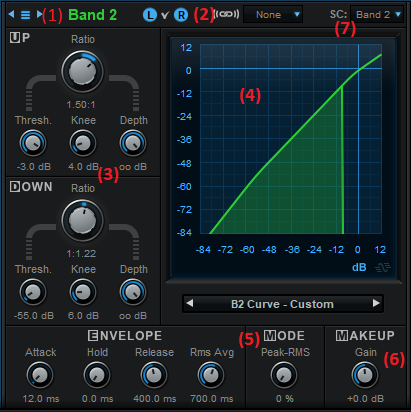
- Manage the current band settings with the band presets menu (copy/paste between bands, save and select preset files...). Note that the side chain source setting is not copied during these operations.
- On the stereo version, several additional controls are available:
- The L and R (or M and S in mid/side mode) buttons let you deactivate any processing applied to any of the channels.
- Choose the type of link between channels for the dynamics response.
- The the upper curve and lower curve sub-sections control the shape of the dynamics response.
- The graph displays the dynamics response of all bands, and shows as an overlay below this response the computed envelope for the current band (computed after the side chain source signal, which is by default the current band). This lets you see exactly how the gain of the dynamics stage is computed.
- The envelope and mode sub-section let you control the time response of the dynamics processor.
- Makeup gain to compensate volume changes.
- Side chain source: select the source band for envelope computation. This setting lets you trigger the effect on the current band using another band, the main input or the external side chain input as a source for envelope computation.
Monitoring Section (7)

- Click on the band number at the top to select the corresponding band. This control is underlined for the selected band.
- Bypass / Mute / Solo: each band can be bypassed (no processing), muted (silent), or soloed (other non soloed bands are muted).
- Level meters: the level meters display both the input and output levels (and the amount of compression or expansion) of the dynamics processing stage. The levels shown do not take the makeup gain into account, so that the actual dynamics treatment applied to the band is clearly visible. The meter that shows the difference between the output and input becomes red for gain reduction and green for gain increase.
- You can respectively adjust the lower and upper thresholds with the appropriate blue and pink sliders.
- Band controls can be linked together (click on R for reverse link) so that adjustements made on one band affect others as well. Note: links do not only affect threshold level, but also the other parameters displayed in the current band. You can quickly toggle all links on & off using the link icon in the main toolbar.
The controls for inactive bands are grayed out (disabled).
Output Section (8)
Below the monitoring section, you can find additional knobs that control the output of the plug-in:

Use the dry/Wet mix knob to achieve parallel compression. The output limiter can be activated and controlled from here.
Browsing Presets
In order to browse both factory and user presets, you can either use the simple presets menu or open the full featured presets browser from the toolbar that remains visible until you close it:
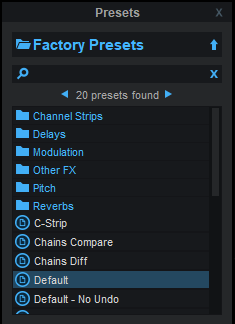
Click on preset files and folders to open them, or use the arrows to navigate between displayed presets. You can navigate upward in the folders tree by clicking on the current folder at the top. Type in the search box to find presets by name (it also searches in folder names). The search is performed recursively in the currently selected folder (displayed at the top).
Search Tips: you can search for multiple terms by separating them with commas. Wildcards are also supported (with * and ? characters), but they are applied to the full path of the preset. For example, to search for all presets containing the word "phase", type *phase* in the search box. To look for these presets only in the factory presets, you can type Factory Presets/*phase*.
The various elements of the user interface (knobs, sliders, buttons...) are simple and intuitive to operate, but more information about how to interact with them is available in the "Plug-ins Basics" chapter of this manual.
Operation
This section will progressively dive deeper into the details of the plug-in, explaining the specificity of each module. A complete list of the parameters exposed by the plug-in is available in the next section.
Setting up the Bands and Crossover Frequencies
How many bands?
The first step is to choose the number of bands. This choice depends on the type of material and the kind of effect you are looking for. If you are not very familiar with multiband dynamics processing, we advise you to start with 3 bands and increase the number of bands later if necessary. Thanks to the available copy/paste commands you can easily transfer your settings to another band.
Setting up the Crossover Points
Be it on a full mix or a single track, at this step your aim is to isolate particular frequencies to apply a specific treatment to it. The best way to adjust the frequency ranges is to use the "Solo" button of the monitoring section to hear the signal processed by each band.
This method also applies to selecting the appropriate filters slopes. You will usually avoid very steep filters (artifacts at the crossover points may be more prominent), but they can be useful to isolate very particular frequencies.
Tranfer Curve Parameters
Changing the shape of the curve: thresholds, ratios and knees
At the heart of the dynamics processor is the transfer curve which shape can be controlled by the usual threshold, ratio and knee parameters. This curve describes the relationship (ratio) between the desired output level and the detected input level. This is where you choose what kind of effect (compression, limiting, gating...) you want to create.
The graph displayed in the Blue Cat's MB-5 Dynamix user interface shows the output level as a function of the input level in dB scale. The controls offered to modify the shape of the dynamics response are explained below.
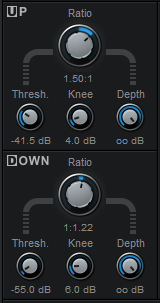
The up threshold and down threshold correspond to the upper part and lower part of the dynamics response curve. They let you specify the upper part (usually for compression) and lower part (usually for gating) of the curve independently:

For each part of the curve (above the up threshold and below the down threshold), you can choose the ratio, which corresponds to the ratio between the output and input levels. In the example above, an infinite to one ratio will be applied to the input signal as soon as it reaches -18 dB (hard limiting), and a 3 to 1 ratio will be applied as soon as it is below 40 dB (gate).
Once you have chosen the ratio, the knee parameter lets you soften the dynamics response. The difference between the left and right graphs below is 10 dB up and down knees:
 |
 |
|
|
Default response (no knee)
|
Response with large knee values |
The effect is applied progressively, whereas with no knee the ratio changes as soon as the threshold is reached.
The depth parameter sets a limit to the amount of gain applied: it is by default set to infinite (no limit). If you decrease it, it sets the largest amount of gain reduction (or increase) that can be applied by the processor. Once this limit is reached, the processor stops increasing this amount.
Makeup gain
When the shape of the dynamics response curve is changed, the maximum peak level might increase or decrease. That's the reason why the plug-in offers a makeup gain, right after the main dynamics processor. This lets you compensate this difference.
Transfer Curve Shapes
We exposed various dynamics processing techniques in the previous chapter. Here are example of dynamics response curves for these techniques.
Upper Curve
Changing the upper curve ratio and threshold lets you create a compressor (limiter) or an expander:
 |
 |
|
|
Compressor
|
Expander |
Lower Curve
With the lower curve controls, it is possible to create a gate or an upward compressor.
 |
 |
|
|
Gate
|
Upward Compressor |
The upward compressor can create interesting effects but can be problematic in the case of noisy input signals because it will magnify background noise. In this case you should first apply a gate in your signal chain to get rid of this noise before or use the depth parameter to limit the gain increase.
Custom Shapes
One of the interests of Blue Cat's MB-5 Dynamix is to create your own shapes that mix these usual behaviors to create custom dynamics effects. For example a combination of a gate and a compressor (that can be used to increase the loudness of a noisy signal):
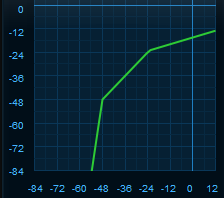
Envelope Parameters
Now that you have chosen the shape of the transfer curve, you can adjust the parameters that drive the envelope follower (the component that computes the input level).
Blue Cat's MB-5 Dynamix offers several envelope detection modes. Unlike most dynamics processors, it lets you choose to work in intermediate modes: it is possible to use half RMS / half peak envelope computation for example.
Peak versus RMS
The Peak mode will detect transients (spikes) in the signal, whereas the RMS mode will measure the loudness of the incoming signal.

Time Parameters
The peak envelope detection has the usual attack and release parameters plus an additional “hold” time that lets you specify how long the detector waits before it starts decreasing. The RMS envelope offers a single parameter corresponding to the time used to run the RMS average.

If you set all these parameters to 0, you obtain a wave shaper/distortion unit.

Stereo Control
With the stereo plug-in, you can choose the way you want the stereo signal to be affected by the dynamics processing. It offers several parameters to fine tune the stereo behavior of the plug-in.
Stereo Mode
Choose between mid/side and left/right processing for the entire plug-in. In the default stereo mode (left/right) left and right channels are processed separately, and in mid/side mode, the plug-in processes the mid and side channels instead. Mid/side processing is described in the introduction section.

Later in this manual we will refer to channel 1 and channel 2 (respectively left and right or mid and side channels depending on the chosen mode).
Stereo Link
In order to keep the stereo balance coherent or on the contrary to modify the stereo perception of a track, you can choose to link the effect applied to each channel in several ways, for each band:
- none: no link. Each channel is independent.
- average: mix the left and right (or mid and side) envelopes to compute the dynamics response. The same gain is applied to both channels.
- min: use the minimum of both envelopes to compute the dynamics response. The same gain is applied to both channels.
- max: use the maximum envelope to compute the dynamics response. The same gain is applied to both channels.
- flip: apply the computed gain of the opposite channel. This enhances the stereo dynamics of the audio signal.
- ch 1 (left or mid): compute the gain only with the envelope from the first channel. The same gain is applied to both channels.
- ch 2 (right or side): compute the gain only with the envelope from the second channel. The same gain is applied to both channels.
Channels Activation
In addition you can choose to activate or deactivate the entire dynamics processing chain for each channel. See the little buttons on top of the band section:
It is possible for example to apply the effect only to the mid channel, and use the side channel as a side chain source (the source that triggers the effect). Several presets use this technique to modify the stereo image.
Parallel Processing
Thanks to the "Dry/Wet" ratio available in the master section, you can adjust the amount of wet signal available at the output of the plug-in. This can be particularly useful to create smooth effects with yet radical settings.
Cross-band Side Chaining
You can select a different band from the current one for envelope detection. This lets you use another band to control the selected dynamics response on another frequency range. It is also possible to use the broadband (unfiltered) input signal for the envelope computation (choose "input").

This unique feature of the plug-in goes beyond traditional multiband dynamics processing and adds a lot of flexibility to the type of effects you can achieve.
You can also select the "External" source for external side chaining:

Brickwall Limiter

The final stage of this plug-in is a brick wall limiter / soft clipper to avoid hard clipping at the output of your host software. A common practice is to use a slow-attack compression stage and then apply the brick wall limiter for harder limiting on remaining transients.
The blue meter on the left of the output level meter shows the amount of limiting applied. The range of this meter is 60 dB.
You can also set the release time to zero. In this case the limiter produces saturation. You can adjust the saturation softness using the Hard-Soft knob.
Tip: it is strongly recommended to activate the brickwall limiter while experimenting with the parameters of the Blue Cat's MB-5 Dynamix plug-in. The plug-in gives you great power to modify the dynamics of the incoming signal, which may result in huge audio spikes in some rare cases. The brickwall limiter protects your monitors and your ears against such mistakes!
Side Chaining
Traditional Side Chaining Mode
As explained in the previius chapter, for each band you can select the "Externql" side chain signal as a source in order to trigger the dynamics processor of the selected band with the external side chain:

Other Side Chaining Modes
Blue Cat's MB-5 Dynamix also lets you use the signal from a track to control any other parameter of another (volume, but also the gain or cutoff frequency of a filter, etc.).
You can either use this side chaining feature to control the global volume of the destination track as shown below, or perform full multi-band side chaining as explained in this tutorial. The methodology is the same, only the target plug-in and the number of parameters to connect differ.
There are two ways of performing this. You can choose the appropriate method depending on the capabilities of your host application and your needs.
Real Time Side MIDI Chaining Mode
Blue Cat's MB-5 Dynamix uses MIDI CC to perform real time side chaining. In order to use this feature, your host application has to support MIDI CC for the plug-ins. You will also need to download Blue Cat's Gain Suite free plug-ins at the following address: http://www.bluecataudio.com/Products/Product_GainSuite. (for full multiband side chaining, see the Blue Cat's MB-7 Mixer plug-in).
The idea is that the Blue Cat's MB-5 Dynamix plug-in is used to perform the envelope detection on the source track, and sends the volume control change messages to the gain plug-in that is instantiated on the destination track:

In order to use the real time side chaining functionality of Blue Cat's MB-5 Dynamix, the procedure is the following:
- Insert Blue Cat's MB-5 Dynamix on the audio source track (the audio track used as control signal for the side chain) (mono or stereo).
- Setup the dry/wet parameter to 0% (all dry) so that the signal on the source track is not affected by the plug-in.
- Insert Blue Cat's Gain plug-in on the destination track (mono or stereo).
- Assign the Total Gain for the selected band (or Bi Total gain(1) and Bi Total Gain(2), where i is the band index) output parameter(s) to a given MIDI channel and CC number.
- Assign the Gain parameter of the Gain plug-in to the same MIDI channel & CC number as the Total Gain parameter.
- Route Blue Cat's MB-5 Dynamix MIDI output to Blue Cat's Gain (usually using a MIDI track, but this step depends on your host application).
- Setup the Blue Cat's MB-5 Dynamix plug-in response curve and time constants for the chosen band. The selected band of the source track controls the effect applied to the destination track.
If you have issues performing the above tasks in your host application, please visit our website and check our step by step tutorials: http://www.bluecataudio.com/Tutorials/
Note: in this mode, the output limiter is not in use.
Offline Automation Side Chaining Mode
If your host does not support MIDI CC, you can still use the side chaining capabilities of the plug-in offline, thanks to its automation support. You will need to record the gain information as an automation curve and apply it to the other track. You can either use Blue Cat's Gain Suite freeware plug-ins or use your host gain automation feature.

The procedure if the following:
- Insert Blue Cat's MB-5 Dynamix on the audio source track (the audio track used as control signal for the side chain) (mono or stereo).
- Setup the dry/wet parameter to 0% (all dry) so that the signal on the source track is not affected by the plug-in.
- Setup the Blue Cat's MB-5 Dynamix plug-in response curve and time constants to obtain the desired effect.
- Insert Blue Cat's Gain on the destination track (mono or stereo).
- Arm the Total Gain (or Bi Total gain(1) and Bi Total Gain(2), where i is the band index) output parameter(s) to record it as automation curves.
- Play the track and record the automation envelope(s) on the source track.
- Copy/paste the envelopes to the destination track.
- Assign the envelope(s) to Blue Cat's Gain plug-in gain parameter(s) or to the destination track volume if provided by the host application.
- Play!
If you have issues performing the above tasks in your host application, please visit our website and check our step by step tutorials: http://www.bluecataudio.com/Tutorials/
Note: in this mode, the output limiter is not in use.
Extending to Advanced Side Chaining Techniques
The usage of MIDI or automation for side chaining in Blue Cat's MB-5 Dynamix lets you extend the traditional usage of side chaining: you can control any parameter of any automatable or MIDI controllable effect. As a result, you can use the dynamics response of a frequency range in a track to control any kind of effect on any other track.
You can for example link the Blue Cat's MB-5 Dynamix output with the gain of an EQ plug-in to instantly create a side chain dynamic EQ, as shown in this tutorial with the Blue Cat's Dynamics plug-in. Possibilities are endless, so we encourage you to experiment with your own effects.
If your host supports it, it is also possible to control MIDI hardware with the plug-in: for example you can control the dynamics of an external synth with a track in your digital audio workstation.
Tips & Tricks
Bypass Unused Bands
In order to minimize the amount of CPU spent by the plug-in, you can bypass the bands that you do not use.
Use Solo and Mute to Tweak the Effect
The Mute and Solo buttons are your friend: they will help you find the hot spots in your signal and choose your frequency bands to apply the effect to the right part of the spectrum.
Protect your Ears with the Brickwall Limiter
While tweaking the parameters of the plug-in and learning to use the software, you should always activate the output brickwall limiter. It will prevent you from damaging your speakers or your ears. You can always deactivate it afterwards, when you are happy with the sound and you can see the limiter does not reduce the output volume.
Stereo Effects
In order to create interesting stereo effects, use the stereo link and mid/side features. They will let you create custom interactions between channels that produce interesting stereo field effects.Cross-Band Effects
Use the side internal side-chaining capability ("SC Input" parameter) to use different parts of the spectrum for envelope detection and gain changes. For example if you want to add treble to the kick drum only, you can use the low end of the spectrum to detect kick hits and send the envelope to a band set as an expander for the high end of the spectrum.Blue Cat Audio Plug-Ins Basics
This chapter describes the basic features that are common to all our plug-ins. If you are already familiar with our products, you can skip this part.
User Interface Basics
About Skins
Like all Blue Cat Audio plug-ins, Blue Cat's MB-5 Dynamix uses a skinnable user interface. It means that the appearance and behavior of the user interface can be entirely customized.
Especially with third party skins, the experience may be quite different from the one offered by the default skins that we provide. However, our plug-ins and our skinning engine have several standard features that will be available whatever your favorite skin.
More information about custom skins can be found in the skins section.
The Main Toolbar
In most skins, an optional toolbar at the top of the user interface gives you access to the main options and settings of the plug-in:

Smooth Bypass
On the left, the power button can be used to smoothly bypass the plug-in.
Presets Area
At the center of the toolbar, you can see the current preset area (the "Default Settings" box). It displays the name of the current preset, with a "*" at the end if it has been modified since loaded.
The arrows on the left and right let you navigate thru the (factory and user) presets available for the plug-in.
Clicking on the preset name opens the presets menu which lets you manage the presets of the plug-in.
Using the knob on the bottom right of this area, you can reduce the opacity of the window, and make it transparent (the actual result may depend on the host application). Additional messages may appear in the area next to this knob, depending on the plug-in.
Some plug-ins may also propose you to manually select the audio I/O inside the plug-in (bottom left of the presets area), regardless of the host configuration. It can be useful for example to save CPU by selecting mono to stereo configurations (instead of full stereo sometimes chosen by default by the host), or add extra channels to manage side chain internally, when the host does not provides any side chain input. Please note that this does not change the number of I/O seen by the host application.
Commands
The icons in the toolbar give you access the to the following commands that are detailed in the next paragraph:
| Icon | Name | Function |
|---|---|---|
|
|
Menu | Open the main menu |
|
|
Control Settings | Display the controls settings menu (to manage automation and MIDI control, as described here). |
|
|
Undo | Undo |
|
|
Redo | Redo |
|
|
Manual | User Manual |
|
|
About | About |
|
|
Zoom | Scale the user interface (from 70% to 200%). |
The Main Menu
The main menu is available from the main toolbar, or if you right click anywhere on the background of the plug-in:
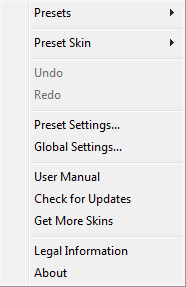
- Presets: opens the presets menu to manage presets.
- Preset Skin: opens the skins menu to choose the skin for the current preset and manage alternative skins for the software.
- Undo/Redo: undo or redo the latest modifications. This includes all changes made to the current preset settings such as MIDI or automation preferences.
- Presets Settings: open the presets settings window. It lets you change the skin, MIDI and automation settings for the current preset.
- Global Settings: open the global settings window. It lets you change the skin, MIDI and automation settings that are used by default in all instances of the plug-in (if not overridden by the current preset).
- User Manual: open this user manual.
- Check for Updates: opens up our website to let you check if any update for this software is available.
- Get More Skins: get more skins for this software.
- Legal Information: browse licensing and misc legal documents.
- About: displays the “about” dialog box.
Controls
Examples
Here are a few examples of typical controls you will encounter in the user interface of our plug-ins:
| slider | slider | knob | button | Text control |
|
|
 |
 |
|
|
Interacting with Controls
You can interact with the controls of the plug-in interface either with the mouse or the keyboard.
Setting the keyboard focus on a control (so that it responds to key strokes) may be automatic (when you pass the mouse over it it gets focus) or manual (you have to click on the control to set the focus on it). Note that all host applications behave differently regarding keyboard handling. In some applications you may not be able to use all keys described later in this manual to interact with our plug-ins. It is usually made obvious to you to know the active surfaces of the skin (the places where you can click with the mouse): the mouse cursor usually changes when you can do something on a control. In the default skins delivered with the plug-in, the cursor changes to a small hand or an arrow to tell you when your mouse is over an active control.
Mouse
Various mouse movements will let you interact with the controls:
| Mouse Interaction | Action |
|---|---|
| Left Click | Acquire focus and start dragging or push (button) |
| Left Click + Alt Key | Set the value to default |
| Left Double Click |
Acquire focus and launch the “fine
tuning” edit box (except button):
 |
| Right Click | Set the value to default |
| Mouse Wheel | Increment or decrement the position (focus required) |
| Mouse Drag | Change the control position depending on mouse movement (except button) |
Keyboard
All control widgets support the following keys (note that some of them are caught by the host and thus never forwarded to the control. For example in Steinberg Cubase SX you cannot use the arrow keys to control the plug-in):
Keys Common to All Controls
| Key | Action |
|---|---|
| Up Arrow | Small increment of the position (up or right) |
| Down Arrow | Small increment of the position (down or left) |
| Left Arrow | Same as Down Arrow |
| Right Arrow | Same as Up Arrow |
| Page Up | Large increment of the position (up or right) |
| Page Down | Large decrement of the position (down or left) |
| + | Small increment of the value of the control |
| - | Small decrement of the value of the control |
| d | Set to default value (same as mouse right click) |
| e |
Opens the 'fine tuning' window to precisely
set the parameter:
 |
| SHIFT | When the key is down, the fine tuning mode is on, and you can modify the value with better precision when moving the mouse, the mouse wheel or using the keyboard. Just release the key to get back to the normal mode. |
Keys Specific to Buttons
| Key | Action |
|---|---|
| Enter | Pushes the button |
Presets
To get started with the plug-in and discover its capabilities, a couple of factory presets are provided. You can also save your own presets and recall them later for other projects. Our plug-ins propose a full-featured preset manager to let you save, browse, organize and recall its presets.
The Presets Menu
The presets menu can be opened from the main menu or the main toolbar. It displays the list of presets available for the plug-in as well as commands to load, save or organize presets:
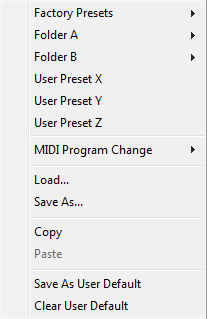
- Factory Presets: shows the list of factory presets delivered with the plug-in.
- "Folder A" to "User Preset Z": user presets and categories.
- MIDI Program Change: activate MIDI Program Change support (see below).
- Load: load preset from file.
- Save: save current state to last loaded user preset.
- Save As: save current preset to a file.
- Copy copy preset to the system clipboard.
- Paste paste preset from the system clipboard, if available.
- Save As User Default: save the current state as the default preset. This preset is used every time a new instance of the plug-in is created.
- Clear User Default: reset the default preset to its factory state: this makes the plug-in forgets the custom settings you might have saved as a default preset.
More about Presets
There are two types of presets: factory presets (read only) that are provided with the plug-in, and user presets that can be created and stored by the user.
The user presets are stored in a subdirectory of the documents folders of your profile ("Documents" on Mac, and "My Documents" on Windows): Blue Cat Audio/[Plug-in Name]/Presets. Each preset is stored as an individual file. You can create folders and subfolders in the Presets directory to classify your presets, as shown in the example below:

If you save a preset named "Default" in the root Presets directory, it will override the factory default preset (that's what "Save As Default" does). To restore the factory default preset, you can just remove this file or use the "Reset Default" command.
MIDI Program Change
It is possible to load presets remotely using MIDI "Bank Select" and "Program Change" messages. To enable this feature, select a MIDI channel to receive the events from in the MIDI Program Change menu item from the presets menu:
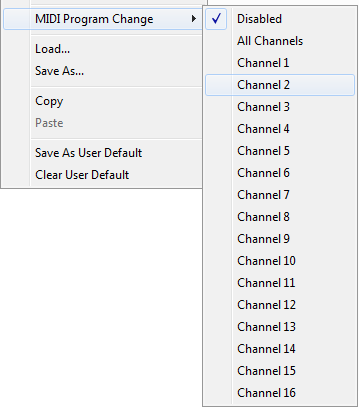
This setting is saved for each plug-in istance with your session but not in presets (except for the default preset, using the "Save as User Default command"). Once activated, the plug-in menu will display the bank number followed by the preset number for each preset:
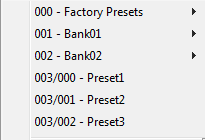
Every root folder is considered as a new bank, starting with the factory presets (bank 0). Program and bank numbers may change while you add folders and presets, so you should be careful when naming them if bank and program numbers matter to you. It is recommended to use folders to make this task simpler. As a side note, sub folders do not define additional banks (all presets contained in sub folders are associated with the current bank.
As specified by MIDI, bank select messages are not used until a program is actually selected.
MIDI Implementation note: the software supports all types of Bank Select methods. You can use either MIDI CC 0 or MIDI CC 32 to select banks. If both are used simultaneously, they are combined together so that you can use more banks (in this case CC0 is LSB and CC32 is MSB, and actual bank number is 128*CC0+CC32).
MIDI and Automation Control
Blue Cat's MB-5 Dynamix can also be remotely controlled via MIDI using MIDI CC ("Control Change") messages or automation curves, if your host application supports it. It is possible to customize the channel, control numbers, range and response curve used for each parameter in the settings panel available from the main menu (see the Plug-in Settings chapter for more details).
MIDI and Automation Settings Menu
The main menu
Most skins also provide the ability to change MIDI and automation settings directly in the main user interface. Clicking on the control settings icon in the main toolbar opens the following menu:
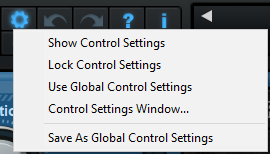
- Show Control Settings: show direct access to individual control settings for each parameter in the user interface (see next paragraph).
- Lock Control Settings: lock the current controls settings for MIDI and automation so that they remain unchanged when loading presets.
- Use Global Control Settings: ignore the current MIDI/automation settings and use the global settings instead.
- Control Settings Window: display the control settings window, to change control settings for all parameters.
- Save As Global Control Settings: save the current settings as global settings (used by default, when no specific MIDI/Automation setting has been set for the cuirrent preset).
Individual Control Settings
When this feature is activated using the "Show Control Settings" item in the MIDI and Automation Settings menu, dropdown menu buttons appears next to the main controls displayed by the plug-in:
Clicking on this button shows the MIDI/Automation settings menu:
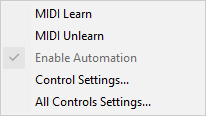
- MIDI Learn: launches MIDI learn mode for the control: touch your MIDI controller and the control will learn from it the MIDI channel and CC number. To end the learn mode, reopen this menu and deselect the option.
- MIDI Unlearn: deactivates MIDI control for this parameter.
- Control Settings: launches the advanced settings panel described below. This controls the settings for the current preset.
- All Control Settings: display the control settings window, with access to all parameters.
Advanced MIDI and Automation Settings
You can completely customize the way the plug-in is controlled by automation and MIDI. For a global view of all parameters at a time, you can use the Plug-in Settings window for the current preset which is available from the main menu.

MIDI Settings:
- Enable MIDI: enable/disable the MIDI control of the parameter.
- Channel: MIDI Channel for the parameter control. If set to 0, the plug-ins will accept Control Change Messages from all MIDI Channels (MIDI Omni mode).
- CC: Control Change Number.
- Learn: click on this button to activate the MIDI learn functionality. When it is activated, you can move your MIDI controller, and the plug-in will automatically set the MIDI Channel and CC Number.
MIDI and automation settings:
- Response: response curve of the MIDI or automation control: from very fast to slow control.
- Min: minimal value of the parameter when MIDI controlled or automated.
- Max: Maximum value of the parameter when MIDI controlled or automated.
Note: if the Min value is higher than the Max value, the response curve will be reversed: increasing the control value will decrease the parameter value.
Note: if you double click on the parameter text control boxes for the max and min values, a “fine tuning” edit box will appear and let you change the min and max values with more precision:

MIDI and Automation Output
Blue Cat's MB-5 Dynamix can also generate MIDI CC Events or automation curves thanks to its output parameters.
You have access to the same settings for the output parameters as you have for input parameters using the dropdown menu, except that you can also enable or disable automation.
The output parameters MIDI and Automation Menu:

The advanced output parameters MIDI and Automation settings window:

More
Check our online tutorial for more screenshots and more examples of our plug-ins user interfaces.
Blue Cat's MB-5 Dynamix Parameters
All parameters described below can be automated and controlled via MIDI if your host application supports it. You can precisely define this behavior in the settings panels described later in this manual.
Input
The input parameters of this plug-in are the following:
| Name | Unit | Description | Comment |
|---|---|---|---|
| General | |||
| Bypass |
|
Bypass the effect. |
|
| Stereo Mode |
|
Choose between stereo (left/right) and mid/side modes. | (stereo version only) |
| Pre Gain | dB | Input gain, before the dynamics processing stage. |
|
| Bands |
|
Number of Bands. |
|
| For each band (band index: i) | |||
| Bi Bypass |
|
Bypass the effect for this band. |
|
| Bi Mute |
|
Mute this band. |
|
| Bi Solo |
|
Solo this band (listen to the band). |
|
| Bi SC Input |
|
Internal side chain input for the current band: choose the signal used for envelope detection (any band or broadband input signal). |
|
| Bi Stereo Link |
|
Defines the link between the left/right or mid/side channels. 0:none, 1:average, 2:min, 3:max, 4:flip, 5:channel 1, 6: channel 2. | (stereo version only) |
| Bi Enable Ch1 |
|
Enable dynamics processing for channel 1. | (stereo version only) |
| Bi Enable Ch2 |
|
Enable dynamics processing for channel 2. | (stereo version only) |
| Bi Peak-RMS | % | Proportion of peak and RMS envelope detection modes. 0% is full Peak, and 100% is full RMS. |
|
| Bi Attack | ms | Attack time for the peak detection. |
|
| Bi Hold | ms | Hold time for the peak detection. |
|
| Bi Release | ms | Release time for the peak detection. |
|
| Bi RMS average | ms | Time for the RMS average computation. |
|
| Bi Up Threshold | dB | Threshold for the upper part of the dynamics response curve. |
|
| Bi Up Ratio | Compression ratio for the upper part of the dynamics response curve. |
|
|
| Bi Up Knee | dB | Knee for the upper part of the dynamics response curve. |
|
| Bi Down Threshold | dB | Threshold for the lower part of the dynamics response curve. |
|
| Bi Down Ratio | Compression ratio for the lower part of the dynamics response curve. |
|
|
| Bi Down Knee | dB | Knee for the lower part of the dynamics response curve. |
|
| Bi Makeup Gain | dB | Gain Compensation at the output of the dynamics stage for this band. |
|
| Freq i - i+1 | Hz | Center frequency for the crossover between this band and the next one. |
|
| Slope i - i+1 | dB/Octave | Slope for the crossover between this band and the next one. Controls the separation between bands (the higher the sharper the separation). |
|
| Output Stage | |||
| Dry-Wet | % | Mix between dry and wet signals (global for all bands). |
|
| Limiter On | Enable or disable the output limiter. |
|
|
| Hard-Soft | % | Control the softness of the output limiter (0% is hard, 100% soft) |
|
| Release | ms | Release time for the output limiter. |
|
| Post Gain | dB | Output Gain (after the brick wall limiter). |
|
| Analysis | Enable or disable the spectrum analysis. |
|
|
| Reset Max In | Reset the maximum input value displayed in the master section (value changes for this parameter trigger reset). |
|
|
| Reset Max In | Reset the maximum output value displayed in the master section (value changes for this parameter trigger reset). |
|
|
Output
Mono and stereo versions of the plug-in offer almost the same outputs. The main difference is that the stereo version exposes the same value twice (one of each channel), except if not specified.
| Name | Unit | Description | Comment |
|---|---|---|---|
| General | |||
| In Level | dB | Audio input Level. | (1) and (2) for the stereo version |
| For each band (band index: i) | |||
| Bi In Level | dB | Audio level at the input of the processing stage for this band. | (1) and (2) for the stereo version |
| Bi Out Level | dB | Audio level at the output of the processing stage for this band. | (1) and (2) for the stereo version |
| Bi Comp | dB | Gain reduction or increase produced by the dynamics processing stage for this band. This value does not include the makeup gain. | (1) and (2) for the stereo version |
| Bi Total Gain | dB | Total Gain reduction or increase produced by the dynamics processing stage for this band, including the makeup gain. | (1) and (2) for the stereo version |
| Output Stage | |||
| Limiter Gain | dB | Gain reduction applied by the output brickwall limiter. |
|
| Out Level | dB | Audio level at the output of the plug-in. | (1) and (2) for the stereo version |
| Max In Level | dB | Maximum value of the Audio level over time at the input of the plug-in (can be reset by "Min Reset" parameter changes) for both channels. |
|
| In Peak Hold | dB | Local Maximum value of the Audio level over time at the input of the plug-in. This value is automatically reset by the plug-in on a regular basis. | (1) and (2) for the stereo version |
| Max Out Level | dB | Maximum value of the Audio level over time at the output of the plug-in (can be reset by "Min Reset" parameter changes) for both channels. |
|
| Out Peak Hold | dB | Local Maximum value of the Audio level over time at the output of the plug-in. This value is automatically reset by the plug-in on a regular basis. | (1) and (2) for the stereo version |
Plug-in Settings
In addition to the controls offered in the main user interface, Blue Cat's MB-5 Dynamix has various settings that let you fine tune the behavior of the plug-in. You can choose to change these settings either for the current preset or globally for all instances of the plug-in.
The Global Settings Window
The settings available in this window apply to all instances of the plug-in, for all presets, if not overridden in the presets settings. Consider these settings as “default” settings.
General
You can change the default skin for all instances of the plug-in: write the skin file path in the text edit box or click on the button to open a file chooser dialog. If you have several instances of the plug-in opened in your session, you will have to re-open the user interfaces of these plug-ins to see the skin change.
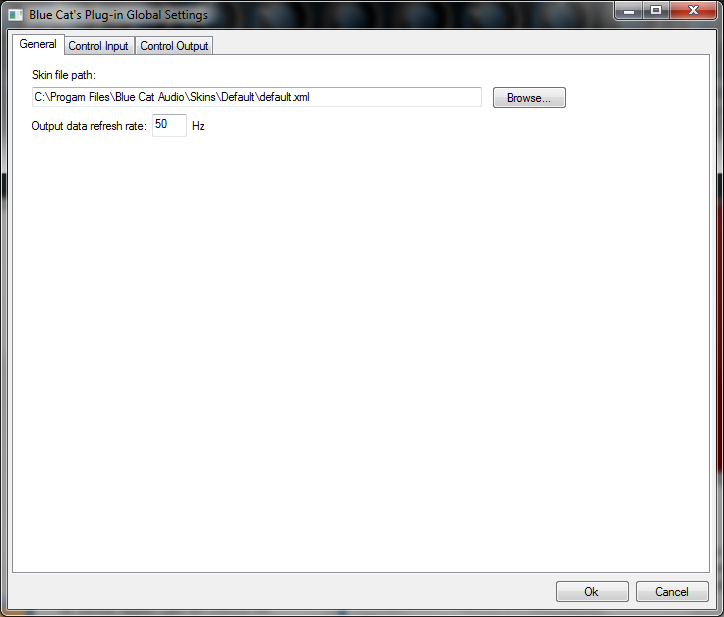
The output data refresh rate can also be customized for all instances of the plug-in. It controls the refresh rate of non-audio data produced by the plug-in (parameters, curves...). It also controls the refresh rate of output MIDI CC messages or output automation data. The higher the refresh rate, the better precision, but also the higher cpu usage (some host applications may also have trouble recording MIDI data at high refresh rates). The default value is 50 Hz.
Global Control Input Settings (MIDI and Automation)
The plug-in offers a couple of settings that affect the way it is controlled by MIDI messages or automation. While the first settings only apply to MIDI control, the "Control Response", "Min" and "Max" settings apply to both automation and MIDI control.
For each parameter you can define a default MIDI channel and CC number. You can then control the plug-in with an external MIDI controller or one of our plug-ins that generate MIDI messages.
The settings below are available for each plug-in parameter.
MIDI Settings:
- Enable MIDI: enable/disable the MIDI control of the parameter.
- Channel: MIDI Channel for the parameter control. If set to 0, the plug-ins will accept Control Change Messages from all MIDI Channels (MIDI Omni mode).
- CC: Control Change Number.
- Learn: click on this button to activate the MIDI learn functionality. When it is activated, you can move your MIDI controller, and the plug-in will automatically set the MIDI Channel and CC Number.
MIDI and automation settings:
- Response: response curve of the MIDI or automation control: from very fast to slow control.
- Min: minimal value of the parameter when MIDI controlled or automated.
- Max: Maximum value of the parameter when MIDI controlled or automated.
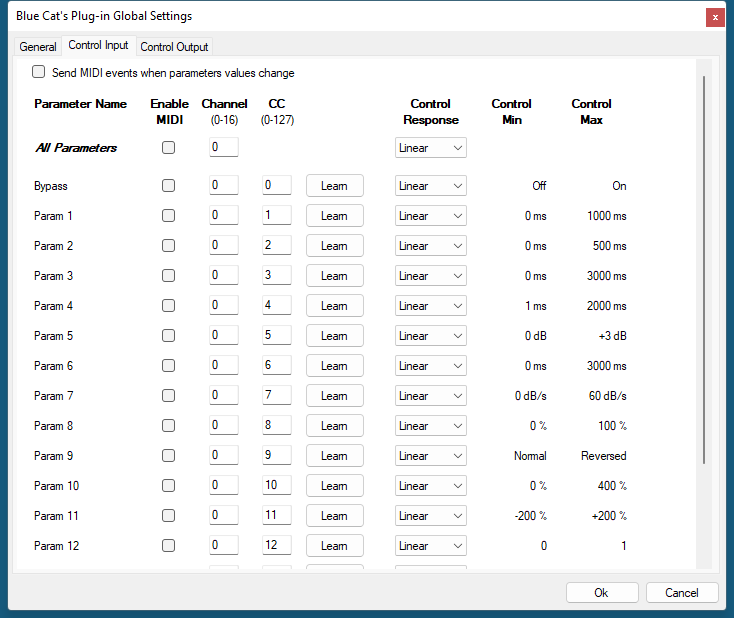
Note: if the Min value is higher than the Max value, the response curve will be reversed: increasing the control value will decrease the parameter value.
Note: if you double click on the parameter text control boxes for the max and min values, a “fine tuning” edit box will appear and let you change the min and max values with more precision:

"Send MIDI events when parameters values change": activate this option when using a control surface that accepts MIDI events as input. MIDI messages will be sent to the output of the plug-in when the user change the parameters values in the user interface, to keep the software and the controller in sync. MIDI is only sent for parameters that are activated for MIDI control.
Global Control Output Settings (MIDI and Automation)
You can set the same properties for the output parameters as for the input parameters: in this case, they may trigger MIDI CC messages or generate automation curves when modified. Since it's output, you cannot set the channel to MIDI Omni, so you must choose a channel.
Output parameters can also generate automation curves in most host applications. You can enable automation for any output parameters you are interested in (see the "Enable Autom." checkbox).
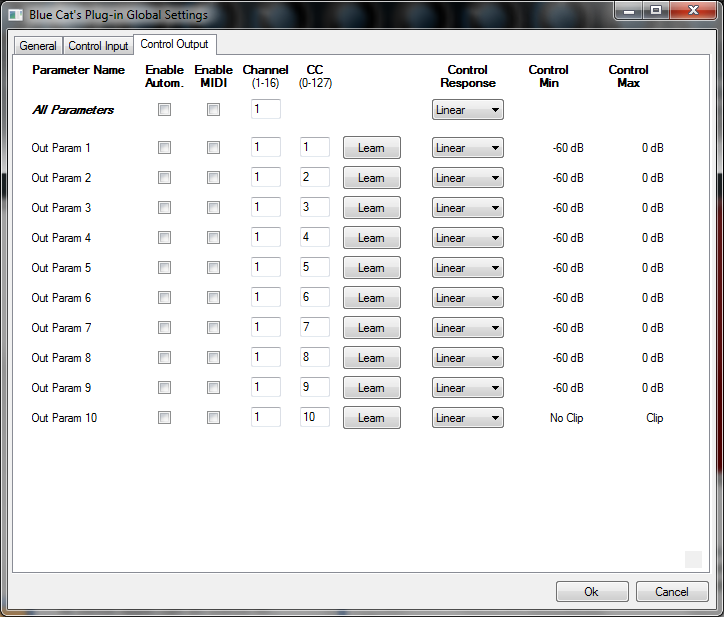
Note: if the Min value is higher than the Max value, the response curve will be reversed: increasing the control value will decrease the parameter value.
Note: if you double click on the parameter text control boxes for the max and min values, a “fine tuning” edit box will appear and let you change the min and max values with more precision:

The Current Preset Settings Window
In this window you can change the settings for the current preset of the current instance of the plug-in only.
Preset Skin
You can choose to use the global skin setting or to change the skin for the current preset. This way you can have different skins for different instances of the plug-in in the same session in order to differentiate them.
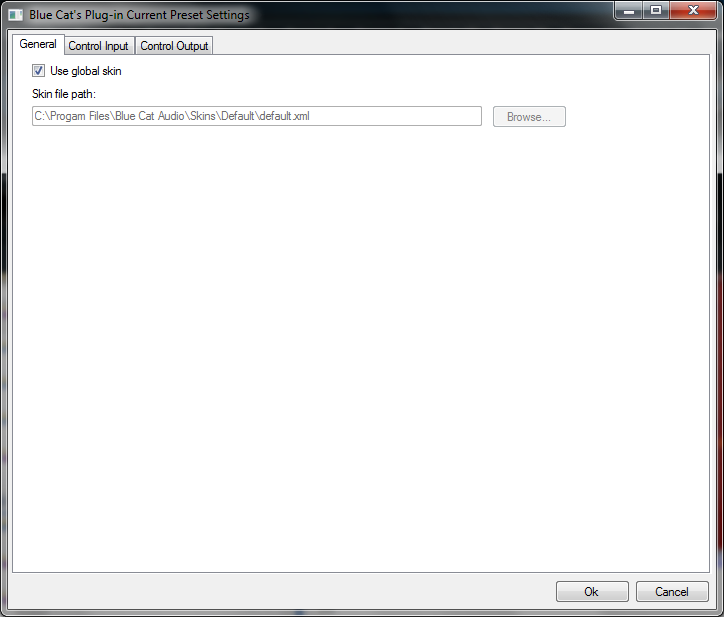
Preset Control Input Settings (MIDI and Automation)
Use the global settings or override them for the current preset. The parameters are the same as for the global input settings.
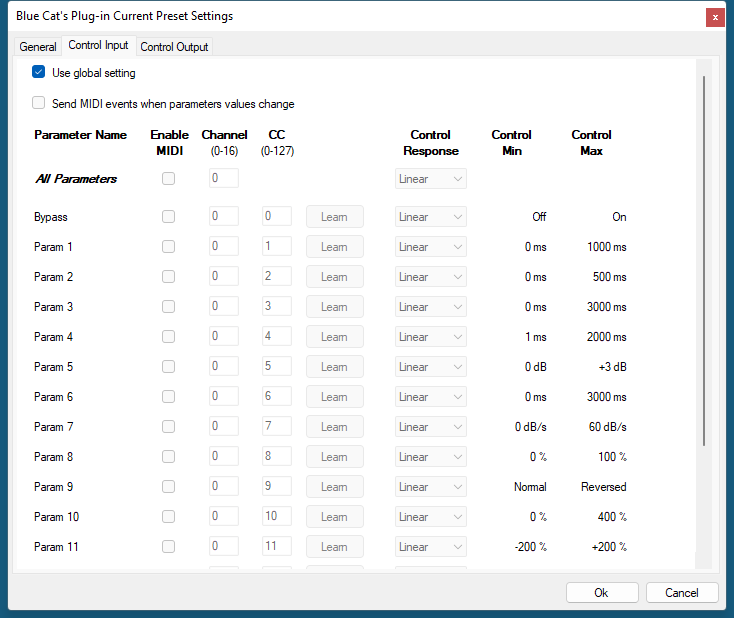
Preset Control Output Settings (MIDI and Automation)
Use the global settings or override them for the current preset. The parameters are the same as for the global output settings.
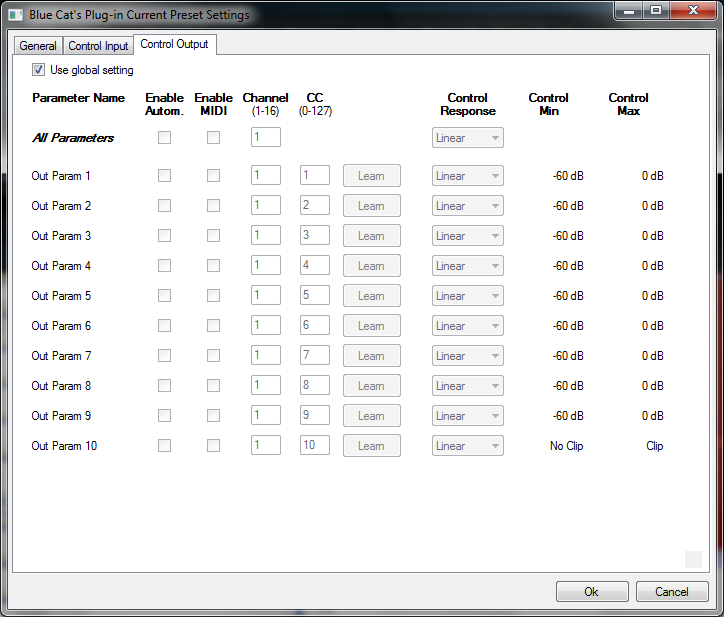
About Skins
Blue Cat's MB-5 Dynamix integrates Blue Cat's skinning engine that allows you to customize the user interface. You can download alternate skins for your plug-in at the following address:
If you don't find a skin that fits your need or if you want a custom one, you can choose to create your own skin.
Choosing the Skin
There are two ways to select the skin of your plug-in: you can change the default (or 'global') skin, or change the skin for the current preset only (either in the preset settings page or from the main menu). The global skin applies to all plug-in instances (choose this one if you want to use the skin used by default, regardless of the session or preset), whereas the current preset skin only applies to the current preset of the current plug-in instance (use this one if you want to change only the skin for the current session/preset).
Note: in some host applications, the plug-in window won't resize automatically when you choose a skin with a different size. In this case, just close the window and re-open it: it will be displayed with the right size.
The Skins Menu
The skins menu can be opened from the main menu. It displays the list of skins available for the plug-in as well as commands to manage the skin used by default when no preset skin has been selected:
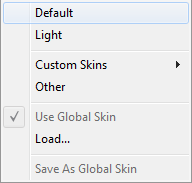
- First Section - Factory Skins: shows the list of factory skins delivered with the plug-in ("Default" and "Light" in this example).
- Second Section - User Skins: shows the list of user skins that have been installed in the Documents Skins folder for the plug-in (see below).
- Use Global Skin: use the global skin for the current preset/session (unloads any custom skin previously selected for the current preset).
- Load: opens a file browser dialog to manually select the skin from the file system.
- Save As Global Skin: use the current preset skin as the global skin (loaded by default if no preset skin has been defined).
Installing User Skins
To select user skins directly from the skins menu, install them in the "Skins" directory available in the plug-in's documents folder:
[Your Documents Folder]/Blue Cat Audio/[Plugin Name]/Skins/
The skin engine will scan this folder for new skins (xml files) and display them in the menu. The skin files should be in the root skins folder or in a subdirectory inside this folder: subdirectories are not scanned recursively.
Other Methods to Select Skins
You can also select the skins in the settings panels available from the main menu:
The global skin (used by default if no preset skin has been selected) can be changed in the global settings pane. The current preset skin can be changed in the preset settings page .
Create a Custom Skin
You can create custom skins for your plug-in in order to adapt it to your exact needs. You can change its look and feel and make it completely integrated in your virtual studio!
Just read the Blue Cat's Skinning Language manual and download the samples for the tutorial on http://www.bluecataudio.com/Skins. You can get ready to create your own skins in a few minutes. You can then share your skins on our website.
More...
This manual only covers the main aspects of Blue Cat's MB-5 Dynamix. Our website offers many additional resources for your Blue Cat's MB-5 Dynamix plug-in. It is constantly updated, so keep an eye on it!
Updates
As you can see in the history log below, we care about constantly updating our products in order to give you the latest technology available. Please visit our website often to check if Blue Cat's MB-5 Dynamix has been updated, or subscribe to our Newsletter to be informed of the latest news about our products.
Note: minor version updates are available from the same location as the original full version download (link received by email upon purchase). The demo version publicly available on our website will not let you register.
You can also follow us on twitter, facebook and instagram for almost real time updates notification, and subscribe to our YouTube channel to watch the latest videos about our software.
Versions History
V2.21 (2022/12/12) |
|
V2.2 (2021/10/19) |
|
V2.11 (2020/07/07) |
|
V2.1 (2019/07/23) |
|
V2.0 (2019/01/10) |
|
V1.21 (2014/03/20) |
|
V1.2 (2013/06/27) |
|
V1.2 (2011/08/31) |
|
V1.11 (2011/02/10) |
|
V1.1 (2010/12/14) |
|
V1.0 (2010/09/06) |
First release. |
Thanks again for choosing our software!

See you soon on www.bluecataudio.com!

